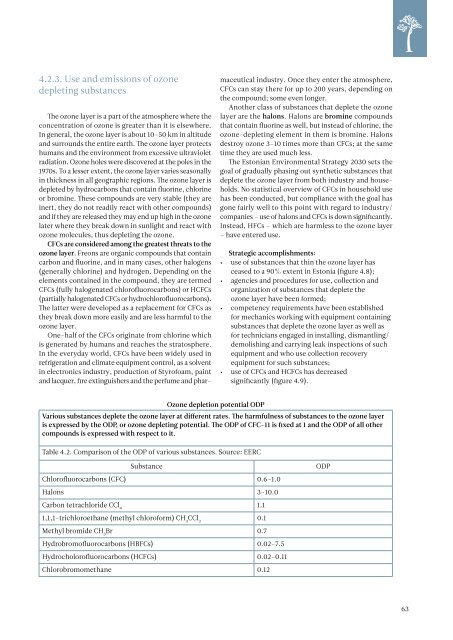ESTONIAN ENVIRONMENTAL REVIEW 2009
ESTONIAN ENVIRONMENTAL REVIEW 2009
ESTONIAN ENVIRONMENTAL REVIEW 2009
You also want an ePaper? Increase the reach of your titles
YUMPU automatically turns print PDFs into web optimized ePapers that Google loves.
4.2.3. Use and emissions of ozone<br />
depleting substances<br />
The ozone layer is a part of the atmosphere where the<br />
concentration of ozone is greater than it is elsewhere.<br />
In general, the ozone layer is about 10–50 km in altitude<br />
and surrounds the entire earth. The ozone layer protects<br />
humans and the environment from excessive ultraviolet<br />
radiation. Ozone holes were discovered at the poles in the<br />
1970s. To a lesser extent, the ozone layer varies seasonally<br />
in thickness in all geographic regions. The ozone layer is<br />
depleted by hydrocarbons that contain fluorine, chlorine<br />
or bromine. These compounds are very stable (they are<br />
inert, they do not readily react with other compounds)<br />
and if they are released they may end up high in the ozone<br />
later where they break down in sunlight and react with<br />
ozone molecules, thus depleting the ozone.<br />
CFCs are considered among the greatest threats to the<br />
ozone layer. Freons are organic compounds that contain<br />
carbon and fluorine, and in many cases, other halogens<br />
(generally chlorine) and hydrogen. Depending on the<br />
elements contained in the compound, they are termed<br />
CFCs (fully halogenated chlorofluorocarbons) or HCFCs<br />
(partially halogenated CFCs or hydrochlorofluorocarbons).<br />
The latter were developed as a replacement for CFCs as<br />
they break down more easily and are less harmful to the<br />
ozone layer.<br />
One-half of the CFCs originate from chlorine which<br />
is generated by humans and reaches the stratosphere.<br />
In the everyday world, CFCs have been widely used in<br />
refrigeration and climate equipment control, as a solvent<br />
in electronics industry, production of Styrofoam, paint<br />
and lacquer, fire extinguishers and the perfume and pharmaceutical<br />
industry. Once they enter the atmosphere,<br />
CFCs can stay there for up to 200 years, depending on<br />
the compound; some even longer.<br />
Another class of substances that deplete the ozone<br />
layer are the halons. Halons are bromine compounds<br />
that contain fluorine as well, but instead of chlorine, the<br />
ozone-depleting element in them is bromine. Halons<br />
destroy ozone 3–10 times more than CFCs; at the same<br />
time they are used much less.<br />
The Estonian Environmental Strategy 2030 sets the<br />
goal of gradually phasing out synthetic substances that<br />
deplete the ozone layer from both industry and households.<br />
No statistical overview of CFCs in household use<br />
has been conducted, but compliance with the goal has<br />
gone fairly well to this point with regard to industry/<br />
companies – use of halons and CFCs is down significantly.<br />
Instead, HFCs – which are harmless to the ozone layer<br />
– have entered use.<br />
Strategic accomplishments:<br />
• use of substances that thin the ozone layer has<br />
ceased to a 90% extent in Estonia (figure 4.8);<br />
• agencies and procedures for use, collection and<br />
organization of substances that deplete the<br />
ozone layer have been formed;<br />
• competency requirements have been established<br />
for mechanics working with equipment containing<br />
substances that deplete the ozone layer as well as<br />
for technicians engaged in installing, dismantling/<br />
demolishing and carrying leak inspections of such<br />
equipment and who use collection recovery<br />
equipment for such substances;<br />
• use of CFCs and HCFCs has decreased<br />
significantly (figure 4.9).<br />
Ozone depletion potential ODP<br />
Various substances deplete the ozone layer at different rates. The harmfulness of substances to the ozone layer<br />
is expressed by the ODP, or ozone depleting potential. The ODP of CFC-11 is fixed at 1 and the ODP of all other<br />
compounds is expressed with respect to it.<br />
Table 4.2. Comparison of the ODP of various substances. Source: EERC<br />
Substance<br />
Chlorofluorocarbons (CFC) 0.6–1.0<br />
Halons 3–10.0<br />
Carbon tetrachloride CCl 4<br />
1.1<br />
1,1,1-trichloroethane (methyl chloroform) CH 3<br />
CCl 3<br />
0.1<br />
Methyl bromide CH 3<br />
Br 0.7<br />
Hydrobromofluorocarbons (HBFCs) 0.02–7.5<br />
Hydrocholorofluorocarbons (HCFCs) 0.02–0.11<br />
Chlorobromomethane 0.12<br />
ODP<br />
63

















